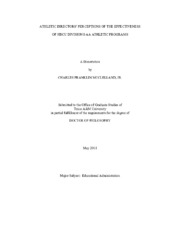| dc.contributor.advisor | Stanley, Christine | |
| dc.creator | McClelland, Charles | |
| dc.date.accessioned | 2011-08-08T22:48:29Z | |
| dc.date.accessioned | 2011-08-09T01:30:19Z | |
| dc.date.available | 2011-08-08T22:48:29Z | |
| dc.date.available | 2011-08-09T01:30:19Z | |
| dc.date.created | 2011-05 | |
| dc.date.issued | 2011-08-08 | |
| dc.date.submitted | May 2011 | |
| dc.identifier.uri | https://hdl.handle.net/1969.1/ETD-TAMU-2011-05-9105 | |
| dc.description.abstract | Few studies were reported in the literature of researchers investigating variables affecting the operation or effectiveness of athletics at HBCUs. This study was designed to identify variables that athletic directors perceived would determine the athletic program's potential for effectiveness in the current NCAA Division I-AA and Division II structure.
A questionnaire instrument containing 66 closed-ended items and a comment section was used to collect data. Fifty-eight positive, closed-response statements in nine categories were organized on a 5-point Likert scale. Another category of eight closed-response items were organized on a 3-point scale. Findings of the investigation included variables that were perceived to determine the effectiveness of football and basketball athletic programs. The following categories of variables were perceived to determine the effectiveness of athletics at HBCUs with Division I-AA football and basketball programs: revenue/funding and its influence, gender equity, NCAA policies and their influence, academics, the student-athlete, diversity, and the expertise of the athletic director. Data were analyzed through descriptive and nonparametric inferential statistics to describe and report findings. For the question, "Do athletic directors at HBCU Division I-AA and non Division I-AA football institutions differ in the proportion of their perceptions of the important variables that influence program effectiveness and the potential for program survival?," the researcher found that directors did not differ in their perceptions of variables that influence program effectiveness. Other findings that resulted from application of the Chi-square test were as follow:
1. Statistically significant differences were not found with respect to age, gender, or institutional size for any category of variables.
2. Statistically significant differences were not found with respect to years of experience for variable categories except for the influence of NCAA policies on football and basketball programs.
3. A statistically significant difference was found for the opinions of all participants on the influence of NCAA policies on football and basketball programs.
Participants‟ comments were analyzed for similar themes and supported that the variables associated with revenue/funding and revenue generating determined the program‟s effectiveness. Participants also commonly acknowledged that tutorials and other support services for student-athletes influenced program effectiveness. These results may be useful to athletic directors and others engaged in planning for the sustainability of athletics at HBCUs. | en |
| dc.format.mimetype | application/pdf | |
| dc.language.iso | en_US | |
| dc.subject | HBCU Athletic Programs | en |
| dc.subject | Effectiveness of HBCU Programs | en |
| dc.subject | Athletic Directors Perceptions | en |
| dc.subject | NCAA | en |
| dc.title | Athletic Directors‟ Perceptions of the Effectiveness of HBCU Division I-AA Athletic Programs | en |
| dc.type | Thesis | en |
| thesis.degree.department | Educational Administration and Human Resource Development | en |
| thesis.degree.discipline | Educational Administration | en |
| thesis.degree.grantor | Texas A&M University | en |
| thesis.degree.name | Doctor of Philosophy | en |
| thesis.degree.level | Doctoral | en |
| dc.contributor.committeeMember | Tolson, Homer | |
| dc.contributor.committeeMember | Ashley, Frank | |
| dc.contributor.committeeMember | Zellner, Luana | |
| dc.type.genre | thesis | en |
| dc.type.material | text | en |


